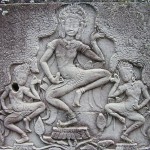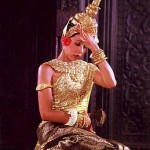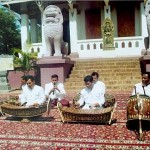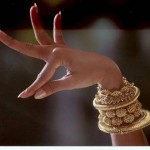People in Cambodia use dance to show the divine power, celebrate the social events, and create laughter in daily life. Cambodian dance can be divided into three different categories: Khmer Classical Dance, Folk Dance, and Vernacular Dance.
Khmer Classical Dance:
This form of dance is also known by a name in English called “Royal Ballet of Cambodia”, and it is listed in UNESCO’s Masterpieces of the Oral and Intangible Heritage of Humanity in 2008. This dance was performed only for royalty meaning the “dances of royal wealth”.
Khmer classical dance is believed to derive from Indian court dance, which traces its origins to the apsaras(see pic1) of Hindu mythology, heavenly female nymphs who were born to dance for the gods. The traditions of Thailand and Java (in Indonesia) also influenced the music and dance of Cambodia.
Over the history of Cambodia, role of Royal Palace’s dancers have become symbols of the King’s prestige. After the signing of the 1863 Protectorate Treaty, the French, who among many other things controlled the country’s finances, tried to reduce the number of palace dancers in order to lessen the King’s prestige. In the 1930s, the French subsidized the private troupe of Princess Wongat Say Sangvann, which performed for tourists, calling it the “one and only true” troupe. But after King Norodom Sihanouk acceded to the throne in 1941, his mother Queen Sisowath Kossamak found ways to reestablish the royal troupe’s ascendancy. In support of her son, Queen Kossamak transformed performances so that the royal troupe could best serve Cambodia’s image nationally and abroad. She shortened the length of the dance programs, had pure dance pieces followed by dramatic or comic works, and added musical interludes.
However, the tradition of dance, last for over a millennium, was almost lost in the Cambodian genocide, when the Khmer Rouge targeted those involved in the dance and “imposed a massive cultural forgetting”. Khmer classical dance suffered a huge blow during the Khmer Rouge regime when many dancers were killed because classical dance was thought as of an aristocratic institution. Although 90 percent of all Cambodian classical artists perished between 1975 and 1979 after the fall of the Khmer Rouge, those who did survive wandered out from hiding, found one another, and formed “colonies” in order to revive their sacred traditions.*
*(Reference: Earth in Flower – The Divine Mystery of the Cambodian Dance Drama by Paul Cravath)
Khmer classical dancers use silent movements and gestures to tell a story. Dancers do not speak or sing; they dance with a slight smile and never open their mouths.(see pic2) Khmer classical dance can be compared to French ballet in that it requires years of practice and stretching at a young age so the limbs become very flexible.
In classical Cambodian dance, women, dressed in brightly colored costumes with elaborate headdresses (also see pic2), perform slow, graceful movements accompanied by a percussive ensemble known as the pinpeat. Pinpeat orchestras include drums, gongs, and bamboo xylophones. (see pic3)
The way Khmer classical dance communicate with audience is very complicated. Different position of the arm and the position of the hand relative to the arm can also express different meaning. Besides hand gestures are gestures which are more specific to their meaning, such as that which is used to represent laughing or flying. These other gestures are performed in different manners depending on which type of character is played.
In addition to the renowned graceful hand gesture(see pic4) and stunning costumes, the Khmer Classical Dance, has been closely associated with the Khmer court for over one thousand years. Performances would traditionally accompany royal ceremonies and observances such as coronations, marriages, funerals or Khmer holidays. This art form is highly cherished by many Cambodians.
Infused with a sacred and symbolic role, the dance embodies the traditional values of refinement, respect and spirituality. Its repertory perpetuates the legends associated with the origins of the Khmer people. Consequently, Cambodians have long esteemed this tradition as the emblem of Khmer culture. Four distinct character types exist in the classical repertory: Neang (woman), Neayrong ( man), Yeak (giant), and Sva (monkey). Each possesses distinctive colours, costumes, makeup and masks. An orchestra accompanies the dance, and a female chorus provides a running commentary on the plot, highlighting the emotions mimed by the dancers, who were considered the kings’ messengers to the gods and to the ancestors.
Classical Cambodian Ballet: Apsara
Folk dance:
Folk dances play a role of performing art to entertain the audience. Khmer folk are fast-paced, and the movements and gestures are not as stylized as Khmer classical dance. Folk dances mostly are about love or the story about animals. The dancers wear costumes that portray ordinary people character, such as farmers, peasants, and tribe leaders. The elements of folk dance diversify profoundly by different area and local cultures. The most famous of all, Robam Trot, is mainly performed during the Cambodian New Year. The Dance got its history along a legend about a hunter and deer.
Vernacular dance:
In Cambodia, vernacular dance (or social dance) is the dance performed at social gatherings. Some of these dances are heavily influenced by the traditional dances of Laos. But rom kbach, for example, take heavily from the classical dance of the royal court. Rom kbach is a simple dance which uses hand gesture similar to that of classical dance and rom kbach song also utilize the melodies of classical dance songs and combine them with traditional Khmer and Western instruments.
Other social dances from around the world have had an impact on Cambodian social cultures include the Cha-Cha,Bolero, and the Madison. Such dances are often performed at Cambodian wedding receptions and banquets.
Yosuke and Tan-Chi





kalian yang suka dance, bisa cari referensi sepatu yang cocok loh di tempat saya artikelsepatu.com
FAP-Nation is a free website Download Games fap nation games, Comics and more. Download Games For Android, Windows, Mac.
As I am looking at your writing, 메이저토토사이트 I regret being unable to do outdoor activities due to Corona 19, and I miss my old daily life. If you also miss the daily life of those days, would you please visit my site once? My site is a site where I post about photos and daily life when I was free.
I was looking for another article by chance and found your article 메이저놀이터 I am writing on this topic, so I think it will help a lot. I leave my blog address below. Please visit once.
Nice to meet you. Your website is full of really interesting topics. It helps me a lot. I have a similar site. We would appreciate it if you visit once and leave your opinion. 토토사이트
I don’t know how many hours I’ve been searching for a simple article like this. Thanks to your writing, I am very happy to complete the process now. 메이저놀이터
I really like it when people come together and share ideas.
Great website, keep it up! 스포츠토토
Hi there to all, how is the whole thing, I think every one is getting more from this website, and your views are good designed for new visitors. 온라인바둑이
I am very impressed with your writing온라인포커 I couldn’t think of this, but it’s amazing! I wrote several posts similar to this one, but please come and see!
this is an amazing article thanks for sharing with us and keep sharing. CIAO 먹튀사이트
Really great article, Glad to read the article. It is very informative for us. Thanks for posting. 스포츠토토
I just passed this onto a friend who was doing some research on that. 안전놀이터
well constructed and very interesting i have bookmarked you hopefully you keep posting new stuff. 경마사이트
Thank you for sharing this knowledge 토토사이트
Great site. Lots of useful information here. I’m sending it to some buddies ans also sharing in delicious. 먹튀사이트
Some truly quality articles on this website , bookmarked . 스포츠토토
Hello, thank you for the good information.
I have good information. I want to take a look.
토토사이트
Nice to meet you. I read the text well. I have good information.
먹튀검증
Kingkong.games ialah salah satu catatan web judi slot online terpercaya 2020 di Indonesia yang sediakan berbagai macam permainan judi online terbaik antara lain judi bola, judi casino online, slot online, tembak ikan, togel serta poker online. Disini, kamu dapat bermain bermacam- macam game taruhan online memakai 1 akun dengan minimun deposit 25 ribu rupiah& minimun withdraw 50 ribu rupiah.
AMBC’s E-Learning System is a Cloud-Based Solution that streamlines course content for improved and accelerated E-learning experiences. AMBC’s E-Learning System is customized to accommodate the distinct learning needs of each team member in the workforce.
Quality articles is the main to interest the visitors to go to see the site, that’s what this website is providing. 토토
Very good post. I certainly appreciate this website. Thanks! 카지노사이트
Hard to ignore such an amazing article like this. You really amazed me with your writing talent. Thank for you shared again. 바카라사이트
Consistently arrives to work on time 온라인카지노.
Is usually able to answer customer questions 카지노사이트.
“She has a knack for thinking outside-the-box 바카라사이트탑.”
Blog de viagem com dicas sobre tudo sobre viagens Viver Viajando
Blog de viagem com dicas sobre tudo sobre viagens Viver Viajando
Blog de viagem com dicas sobre tudo sobre viagens Viver Viajando
wow, Amazing content! I am really excited to see this on internet. 온라인카지노
I loved the information regarding your high class blog posting, i am so much graceful to you. 온라인카지노
Very good and interesting to read, makes me understand new things.
if possible, 스포츠토토 hopefully you can share experiences. thank you very much!
Pretty good post. I just stumbled upon your blog and wanted to say that I have really enjoyed reading your blog posts. 바카라사이트
this website is greatly. and good thanks give access me to comment your blog spot. 카지노사이트
Of course, your article is good enough, 먹튀검증 but I thought it would be much better to see professional photos and videos together. There are articles and photos on these topics on my homepage, so please visit and share your opinions.
Nice post. Your writing style is very beautiful and your article is very attractive. 안전놀이터
I’m sure everyone will appreciate this interesting things. 온라인경마
Thanks for sharing this information. I have shared this link with others to keep posting such information to provide the best in class assignment help online at very affordable prices.
International Law Assignment Help
International Law Assignment
Assignment on Sources of International Law
International Law Assignment Topics
Mass Communication Assignment Help
Mass Communication Assignment
Functions of Mass Communication Assignment
Entrepreneurship Assignment Help
Entrepreneurship Assignment
Entrepreneurship and Small Business Management Assignment
statistics assignment help
Remarkable! Its in fact remarkable piece of writing, 토토사이트
I have got much clear idea on the topic of from this article.경마사이트
Wonderful blog post. This is absolute magic from you! 먹튀검증
Assignment Help
Assignment Help
statistics assignment help
python assignment help
Economics Homework Help
Digital Marketing Assignment Help
Rstudio Assignment Help
Well I truly enjoyed reading it. This tip offered by you is very useful for correct planning. 먹튀검증
I am glad to be a visitor of this double dyed website! , appreciate it for this rare information! 토토사이트핫
I visited a lot of website but I think this one has something extra in it in it 먹튀검증
olymptrade web muncul di pasar opsi pada tahun 2014. Sejak itu, kami terus menciptakan yang baru dan meningkatkan yang lama, sehingga perdagangan Anda di platform ini lancar dan menguntungkan. Dan itu hanyalah permulaan.
Hey there! I would like to share an enlightening post with you https://300writers.com/hire-discussion-board-post-writer.html Visit a site to check out enlightening articles. There also work professional writers who can help with any task.
Usually needs direct supervision, even for mundane and everyday tasks 릴게임.